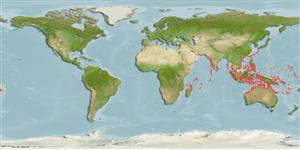>
Gobiiformes (Gobies) >
Gobiidae (Gobies) > Gobiinae
Etymology: Trimma: Greek, trimma, -atos = something crushed (Ref. 45335).
Eponymy: Dr Stefan Meiring Naudé (1904–1985) was a South African physicist who was Professor of Physics at Stellenbosch University (1934–1946). [...] (Ref. 128868), visit book page.
More on author: Smith.
Environment: milieu / climate zone / depth range / distribution range
Ecologia
marino associati a barriera corallina; distribuzione batimetrica 3 - 30 m (Ref. 1602), usually 3 - 30 m (Ref. 27115). Tropical; 22°C - 26°C (Ref. 27115); 30°N - 22°S
Indo-West Pacific: Seychelles, Aldabra, Chagos Islands, Ryukyu Islands, and Loyalty Islands; Mariana and Marshall islands in Micronesia.
Size / Peso / Age
Maturity: Lm ? range ? - ? cm
Max length : 3.5 cm SL maschio/sesso non determinato; (Ref. 48637)
Short description
Chiavi di identificazione | Morfologia | Morfometria
Spine dorsali (totale) : 7; Raggi dorsali molli (totale) : 7 - 8; Spine anali: 1; Raggi anali molli: 7 - 9. Diagnosis: a frontal ridge behind the orbits that slopes steeply into a wide interorbital trench
anteromedially, and into postorbital trenches laterally; posterior nasal opening separate from eye; second spine of first dorsal fin elongate, third spine occasionally elongate; fifth pelvic fin ray branched once dichotomously; body color orange-red with seven dorsolateral white spots
between posterodorsal margin of the peduncle and origin of first dorsal, and with four ventrolateral spots between posteroventral margin of peduncle and origin of last anal ray; facial pattern uniform dusky orange-grey colour under orbit, with an orange vertical blotch, edged in melanophores on vertical limb of the preopercle resembling a club; conspicuous bar of melanophores extending vertically across posterior margin of pectoral base (Ref. 57688).
Occurs in lagoons and seaward reefs; on rubble and reef rock (Ref. 1602); also over coral patches interspaced with fine sandy bottoms, occasionally form small schools (Ref. 37688). Feeds on copepods, ostracods, and radiolarians (Ref. 1602).
Life cycle and mating behavior
Maturità | Riproduzione | Deposizione | Uova | Fecundity | Larve
Myers, R.F., 1991. Micronesian reef fishes. Second Ed. Coral Graphics, Barrigada, Guam. 298 p. (Ref. 1602)
IUCN Red List Status (Ref. 130435: Version 2024-2)
Threat to humans
Harmless
Human uses
Pesca: commerciale; Acquario: Commerciale
Strumenti
Special reports
Download XML
Fonti Internet
Estimates based on models
Preferred temperature (Ref.
123201): 25.3 - 29, mean 28 °C (based on 1090 cells).
Phylogenetic diversity index (Ref.
82804): PD
50 = 0.5000 [Uniqueness, from 0.5 = low to 2.0 = high].
Bayesian length-weight: a=0.01023 (0.00477 - 0.02194), b=3.01 (2.83 - 3.19), in cm total length, based on LWR estimates for this (Sub)family-body shape (Ref.
93245).
Trophic level (Ref.
69278): 3.3 ±0.42 se; based on food items.
Resilienza (Ref.
120179): Alto, tempo minimo di raddoppiamento della popolazione meno di 15 mesi (Preliminary K or Fecundity.).
Fishing Vulnerability (Ref.
59153): Low vulnerability (10 of 100).
Nutrients (Ref.
124155): Calcium = 263 [124, 654] mg/100g; Iron = 1.28 [0.61, 2.50] mg/100g; Protein = 18.3 [16.3, 20.0] %; Omega3 = 0.174 [0.069, 0.381] g/100g; Selenium = 24.6 [10.2, 55.9] μg/100g; VitaminA = 147 [39, 539] μg/100g; Zinc = 3.11 [1.90, 4.84] mg/100g (wet weight);
